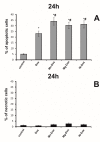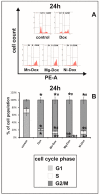Newly Synthesized Doxorubicin Complexes with Selected Metals-Synthesis, Structure and Anti-Breast Cancer Activity
- PMID: 28677642
- PMCID: PMC6152354
- DOI: 10.3390/molecules22071106
Newly Synthesized Doxorubicin Complexes with Selected Metals-Synthesis, Structure and Anti-Breast Cancer Activity
Abstract
Doxorubicin (DOX) is very effective chemotherapeutic agent, however it has several major drawbacks. Therefore the motivation for developing novel drug complexes as anticancer agents with different mechanism of action has arisen. The aim of the present study was to evaluate the influence of newly synthesized DOX complexes with selected metals (Mg, Mn, Co, Ni, Fe, Cu, Zn) on apoptosis, cell cycle, viability, proliferation and cytotoxicity in the breast cancer cell line MCF-7. Complexation of DOX with metals has likewise been the subject of our research. The current work showed that the tested bivalent metals at a given pH condition formed metal:DOX complexes in a ratio of 2:1, while iron complexes with DOX in a ratio of 3:1. The studies also showed that selected metal-DOX complexes (Mg-DOX, Mn-DOX, Ni-DOX) at 0.5 µM concentration significantly decreased cell viability and proliferation, however they increased caspase 7 activity. Results also indicated that studied metal-DOX complexes showed high cytotoxicity in MCF-7 cells. Therefore they were chosen for cell cycle check-points and apoptosis/necrosis analysis studied by flow cytometry. Obtained results suggest that doxorubicin complexed by specified metals can be considered as a potential anti-breast cancer agent, which is characterized by a higher efficacy than a parent drug.
Keywords: MCF-7; breast cancer; doxorubicin; metals.
Conflict of interest statement
The authors declare no conflict of interest.
Figures













References
-
- Szuławska A., Czyż M. Molekularne mechanizmy działania antracyklin. Post. Hig. Med. Dośw. 2006;60:78–100. - PubMed
-
- Missailidis S. Anticancer Therapeutics. John Wiley & Sons; Chichester, UK: 2008. pp. 53–54.
MeSH terms
Substances
LinkOut - more resources
Full Text Sources
Other Literature Sources
Medical

